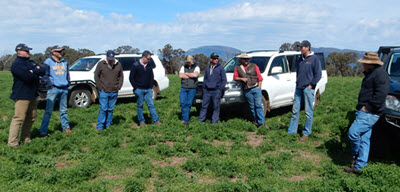Finding the perfect pasture mix

In western Victoria, where perennial pastures dominate livestock systems, producers are trialling high value annual forage options to diversify the feedbase.
For the next three years, the region’s Perennial Pasture Systems group will investigate ‘best fit’ annual pastures for local conditions through an MLA Producer Demonstration Sites (PDS) project.
Perennial Pasture Systems Project Manager Rob Shea said perennial pasture establishment is an important part of the lamb production system in the Wimmera region. However, with sowing and establishment costs of up to $450/ha, it can be risky if the right amount of rain doesn't fall at the right time.
Perennial and annual species go hand-in-hand
According to Rob, there is a recent trend among producers to compliment perennial pastures with a small area of high production annual forage species, especially ryegrass.
“The aim is to try fill a feed deficit during winter and early spring, when quality pasture is required for pregnant or lactating ewes,” he said.
“We need to protect long-term perennial pastures from overgrazing early in the season.”
Establishing trial sites
The group’s PDS project involves setting up 12 local trial sites on member properties in the next three years.
Trials will help members and other producers in the region better understand the production, financial and grazing management benefits of incorporating high production annual forages, such as annual ryegrass and arrowleaf clover, in the region’s perennial grazing systems, which are typically based on phalaris species.
“We want to demonstrate how producers can best combine annual and perennial pastures, the benefits and drawbacks and likely productivity improvements – especially in lamb production – as part of mixed cropping and livestock systems,” Rob said.
Through the PDS trials, production measures such as pasture growth rates, sheep live weights/condition scores will be established and an overall cost–benefit analysis will be conducted.
Fine-tuning the feed system
Simon and Yvette Brady, group members who are hosting one of the PDS sites on their property ‘Jallukar Park’, hope the trials will reveal annual species to help them increase the carrying capacity of perennial pastures.
Their goal is to develop a feedbase to improve livestock productivity, increase ground cover, reduce salinity risk and minimise nitrate leaching.
Grazing is restricted to light gravel and sandy soil areas not suited to cropping that are sown to phalaris-based perennials that will persist long-term.
Sheep are contained in small areas for supplementary feeding from late summer until after the autumn break, allowing pastures to rest to help fill the feed gap during early winter and spring.
Arrowleaf clover and Winteroo oats are sown on areas of up to 100ha each year (pending seasonal conditions) as part of the cropping rotation.
Simon said the aim is to provide quality fodder in the pasture phase, while building soil nitrogen (N) to be used in the cropping phase. Low fertility soils are also treated with a targeted fertiliser and lime.
Grazing sheep on annual pastures and oats during winter allows the phalaris pasture to be spelled in preparation for spring lambing, while providing flexibility.
“When we graze the oats, we put sheep on the crop about six weeks after sowing – which is done around the time of the autumn break – and rotate them in small areas using semi-permanent fencing,” he said.
“We can often harvest that crop after grazing."
Simon said this type of fencing for cell-type grazing is a relatively low cost option that has potential to boost the carrying capacity of the phalaris pastures in spring to about 15–20 dry sheep equivalent (DSE)/hectare on areas that would traditionally carry 5–8 DSE/ha.
“What we’ve seen in the trial to date is that we’re able to run about 25 DSE/ha on the annual pasture and oats area,” Simon said.
“In coming weeks and months, we’ll be measuring and analysing the stocking rate and pasture production from the phalaris pasture area that has been able to get away for a spring flush this year.”
More information
Rob Shea
Project Manager, Perennial Pasture Systems
T: 0438521357
E: yadin@netconnect.com.au
perennialpasturesystems.com.au
Michael Crowley
General Manager – Producer Consultation and Adoption, MLA
E: mcrowley@mla.com.au



